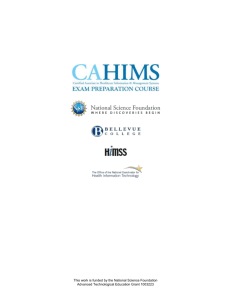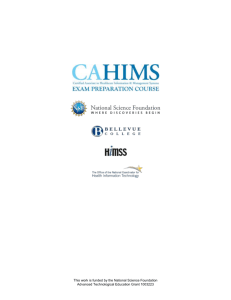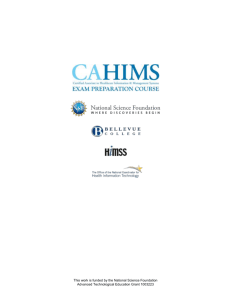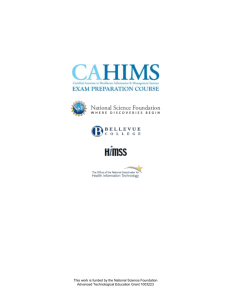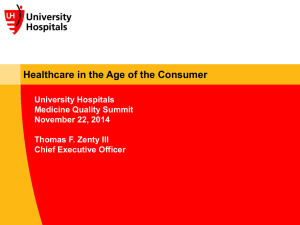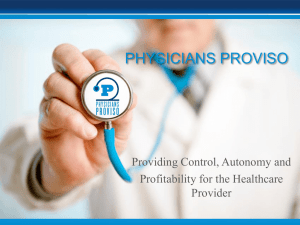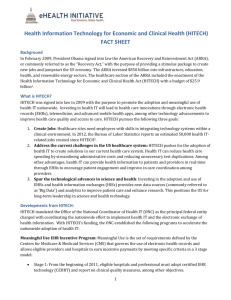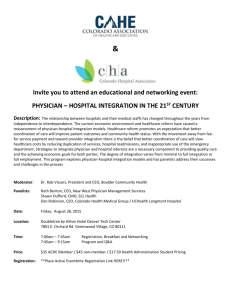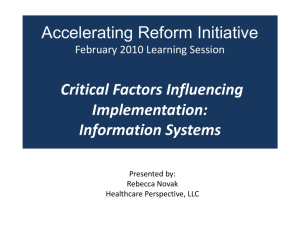1.4-Assessment-Key
advertisement
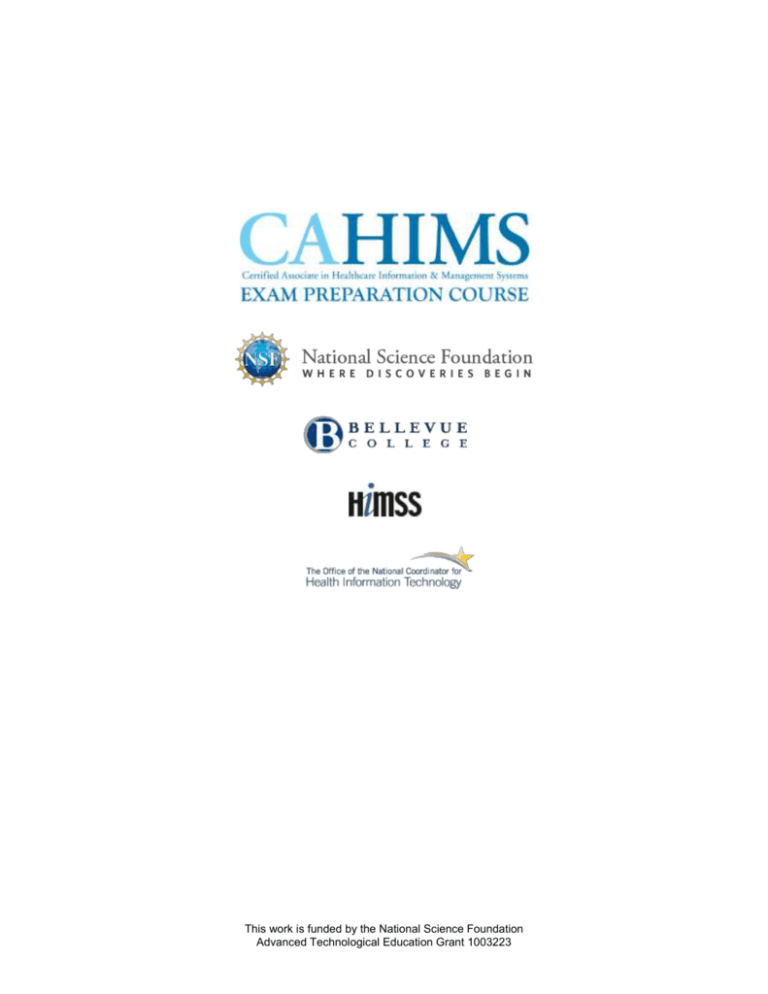
This work is funded by the National Science Foundation Advanced Technological Education Grant 1003223 The CAHIMS Exam Preparation Course and the CAHIMS exam are the result of collaboration between the Life Science Informatics Center at Bellevue College and the Healthcare Information and Management Systems Society (HIMSS). Significant content found in the CAHIMS Exam Preparation Course stems from the Office of the National Coordinator for Health Information Technology. Creation of the CAHIMS Exam Preparation Course and the CAHIMS exam was made possible through support from the National Science Foundation (NSF). Curriculum Team: Margaret Schulte, DBA Michèle Royer, PhD Nathan Savage, MLIS This work is funded by the National Science Foundation Advanced Technological Education Grant 1003223 Section 1 - Healthcare Environment Lesson 1.4 - Government Regulation and Certification Assessment Questions Answer Key Lectures 1, 2, 3, 4 & 5 1. The Joint Commission (formerly known as JCAHO) accredits: *a. Entire healthcare organizations b. Outpatient healthcare providers c. Just nurses d. Just physicians Answer: a Lecture(s)/Slide(s): 1/6 2. What organization developed the National Patient Safety Goals, the Sentinel Event Policy, and the Speak Up Initiative? a. The Agency for Healthcare Research and Quality b. The Health Resources and Services Administration *c. The Joint Commission d. The Office of the Inspector General Answer: c Lecture(s)/Slide(s): 1/9 3. Which of the following is one of the main roles of the FDA? *a. Regulate drug safety b. Prevent wrong-site surgery c. Encourage patients to participate actively in their healthcare d. Develop performance measures for hospitals Answer: a Lecture(s)/Slide(s): 1/6 This work is funded by the National Science Foundation Advanced Technological Education Grant 1003223 Page 1 4. Negligence is one of the two main types of: a. Felonies b. Litigation *c. Torts d. Violations of administrative law Answer: c Lecture(s)/Slide(s): 2/14 5. Administrative Hearings would be held for: *a. Social Security Appeals b. Civil litigation c. Criminal Cases d. Malpractice Claims Answer: a Lecture(s)/Slide(s): 2/19 6. In order to prove medical malpractice, an injured person must prove all of the following EXCEPT: a. The health provider had a duty of reasonable care. b. The health provider did not meet the minimum standard of care or failed to obtain informed consent. c. The health provider’s failure to meet the standard of care was the primary cause of the injury. *d. The injury resulted in physical harm. Answer: d Lecture(s)/Slide(s): 3/13 7. The Affordable Care Act is slated to: a. Provide better access to insurance b. Improve public health c. Increase Medicaid and Medicare payments *d. All of the above Answer: d Lecture(s)/Slide(s): 3/4 This work is funded by the National Science Foundation Advanced Technological Education Grant 1003223 Page 2 8. Lack of informed consent can lead to accusation of: a. Battery b. Negligence c. Malpractice *d. All of the above Answer: d Lecture(s)/Slide(s): 3/10 9. Fraud is: *a. The intentional misrepresentation or concealment of relevant facts b. Unnecessary costs as a result of poor management, practices, or controls c. Excessively or improperly using government resources d. Pre-determined non-economic damage Answer: a Lecture(s)/Slide(s): 3/20 10. Which of the following is not true of HIPAA? *a. New employer plan may limit coverage due to pre-existing condition b. Improves access to long term care c. If health insurance is lost, improves access to group health plan d. Protects use of health savings accounts Answer: a Lecture(s)/Slide(s): 4/3 11. The HIPAA Security Rule: a. Ensures compliance by the workforce b. Requires covered entities to use security measures to protect health information c. Anticipates threats to security and integrity of information, and protects against them *d. All of the above Answer: d Lecture(s)/Slide(s): 4/11 This work is funded by the National Science Foundation Advanced Technological Education Grant 1003223 Page 3 12. The following government agency enforces HIPAA: a. FDA b. AHRQ c. JC *d. OCR Answer: d Lecture(s)/Slide(s): 4/12 13. A government agency that is an important source on research about patient safety and privacy is: *a. AHRQ b. JC c. OCR d. FDA Answer: a Lecture(s)/Slide(s): 4/17-19 14. A clinical documentation improvement (CDI) program strives to: a. Improve the quality of documentation in the health record b. Reduce fraud and abuse c. Improve the coding and reimbursement process *d. All of the above Answer: d Lecture(s)/Slide(s): 5/7 15. The health record is: a. A communication tool among care providers b. A tool to improve quality and safety for patients c. The legal business record of a healthcare organization *d. all of the above Answer: d Lecture(s)/Slide(s): 5/3-4 This work is funded by the National Science Foundation Advanced Technological Education Grant 1003223 Page 4 Lectures 6 & 7 16. HITECH addresses which of the following barriers to using health information technology? *a. There is a shortage of health IT support staff. b. Patients cannot afford Personal Health Records. c. Doctors prefer to use paper charts. d. Patients don’t trust doctors who use computers. e. There are not enough electronic health record vendors. Answer: a. There is a shortage of health IT support staff. Lecture(s)/Slide(s): 6/6, 13-17 17. Which of the following is an example of HITECH’s concept of “meaningful use” of health IT? a. Having a nurse enter the doctor’s orders into the EHR b. Printing prescriptions legibly so they can be entered accurately into the information system *c. A primary care physician electronically exchanging a patient’s laboratory data with a medical specialist d. Patients using the Internet to obtain information about a patient’s disease e. A pharmacist using a drug interaction checker Answer: c. A primary care physician electronically exchanging a patient’s laboratory data with a medical specialist Lecture(s)/Slide(s): 7/10, 20 This work is funded by the National Science Foundation Advanced Technological Education Grant 1003223 Page 5 18. What kind of job role is likely to be a part of a REC? a. Software engineer b. Research informatician *c. Implementation manager d. Chief medical information officer e. Privacy and security officer Answer: c. Implementation manager Lecture(s)/Slide(s): 6/14-16 19. HITECH’s Workflow Process and Redesign specialists address which of the following problems? a. Hospital workflow needs to be changed in order to increase safety when using health IT. b. Physician office workflow needs to be made more efficient. c. Doctors clinical processes need to be redesigned so computers can decrease costs. d. Office furniture has to be redesigned to accommodate computers. *e. Electronic health records have to fit in with a practice’s workflow. Answer: e. Electronic health records have to fit in with a practice’s workflow. Lecture(s)/Slide(s): 6/16 20. Which of the following barriers to health information exchange are NOT addressed by HITECH? a. There are few agreed-upon technical standards for health IT. b. The transfer of information between institutions is not secure. c. There are few statewide examples of health information exchange. *d. Hospitals may lose competitive advantage if they exchange information with others. Answer: d. Hospitals may lose competitive advantage if they exchange information with others. Lecture(s)/Slide(s): 7/18-23 This work is funded by the National Science Foundation Advanced Technological Education Grant 1003223 Page 6 21. Which of the following is a major part of the HITECH vision? a. Reduction of out-of-pocket costs to patients b. Assuring that primary care physicians earn as much as specialists *c. Increased transparency and efficiency d. Patients taking more responsibility for their own health e. Insurers not discriminating against patients who have pre-existing conditions Answer: c. Increased transparency and efficiency Lecture(s)/Slide(s): 6/12 22. The incentives for health IT are focused on getting a. as many physicians as possible to purchase electronic health records. *b. physicians to use health IT to improve healthcare quality. c. vendors to develop systems with the newest features. d. patients to use health IT for medication management. Answer: b. physicians to use health IT to improve healthcare quality. Lecture(s)/Slide(s): 7/10-16 23. The HITECH Act provides funding for collaborative research projects known as: *a. SHARP b. HITCR c. CRPIT d. SECURE Answer: a. SHARP Lecture(s)/Slide(s): 7/25 24. Which of the following HITECH programs supports health reform efforts that emphasize use of health information technology? a. Virtual Physician Programming b. Clinical TECH Modeling Centers *c. Curriculum Development Centers d. HITECH Doctor television programming Answer: c. Curriculum Development Centers Lecture(s)/Slide(s): 6/19 This work is funded by the National Science Foundation Advanced Technological Education Grant 1003223 Page 7 25. As the HITECH Act progresses into implementation, monetary incentives through CMS will require the use of certified EHRs. Which option explains the benefit to the practitioner for using a certified EHR? a. Early financial gains and long-term financial benefits b. HITECH assistants for implementation c. Premium quality EHRs that fit practitioners’ workflow designs *d. Standardized and approved functions for health information exchange Answer: d. Standardized and approved functions for health information exchange Lecture(s)/Slide(s): 7/23 This work is funded by the National Science Foundation Advanced Technological Education Grant 1003223 Page 8


